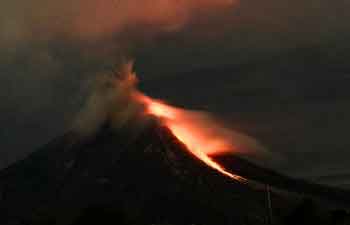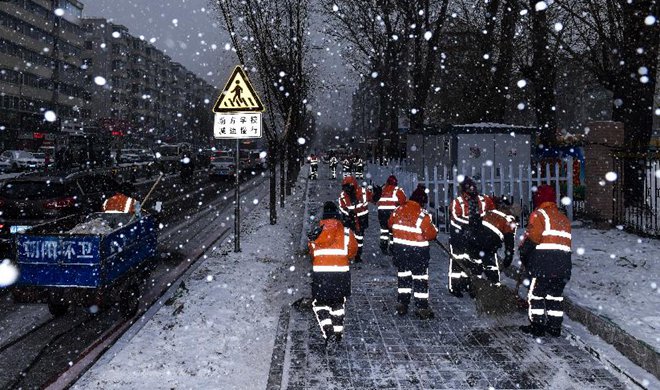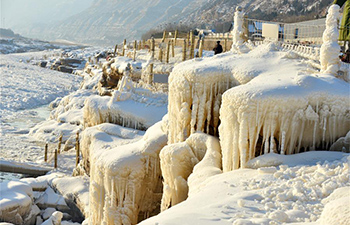LOS ANGELES, Jan. 13 (Xinhua) -- The local authority in the north Pacific U.S. State of Hawaii apologized for a false emergency alert on Saturday morning warning residents of an imminent ballistic missile threat, which had caused panic cross the islands.
According to a timeline outlined by Hawaii Emergency Management Agency (EMA) Administrator Vern Miyagi at a press conference Saturday afternoon, an emergency text alert was sent to cellphones at about 8:07 a.m. local time (1807 GMT), reading in all caps that "Ballistic missile threat inbound to Hawaii. Seek immediate shelter. This is not a drill."
Meanwhile, the false alert was also broadcast on local television, warning "If you are outdoor, seek immediate shelter in a building. Remain indoors well away from windows. If you are driving, pull safety to the side of the road and seek shelter in a nearby building or lie on the floor. We will announce when the threat has ended."
The authority started the recall and cancellation process no later than 8:10 a.m. (1810 GMT). However, there was no way to wipe out the messages that have been sent out, so they looked to Twitter to tell the public the alert was a false alarm, but not everyone was on the social media platform.
It took the EMA a full 38 minutes to manually generate and disseminate another corrective emergency alert that reached all Hawaiians, but the state was in uproar at that time.
Video shows students at the University of Hawaii at Manoa running for cover and hiding in classrooms in wake of the emergency alert.
"First instinct was to jump out of bed and figure out what was going on. I got a bag and threw my water and some food in it," Luke Clements, a student, was quoted as saying by local media Hawaii News Now.
"We're coming down outside of Frear (Hall) and see people running past us. There were a group of people crying," said Clements.
Sara Donchey, who said she was in Honolulu, Hawaii, tweeted that her family who were on the North Shore "were hiding in the garage. My mom and sister were crying."
"It was a false alarm, but betting a lot of people are shaken," she wrote.
Wu Qing, a Chinese scholar working in Hawaii, told Xinhua in a phone interview that she still felt frightened.
"I was still sleeping when I received message in the morning. Several of my friends also called me or informed me through the WeChat app after missile alert mistake," said Wu.
Many local residents had a sense of "surviving a disaster" and are thankful it was just an error, she added.
"I was just scared. How can the emergency agency make a mistake like that?" wrote a student named Tian on WeChat Moment.
The U.S. military's Pacific Command and state authorities confirmed to public later that there was no missile threat to Hawaii, which is a chain of islands in the Pacific Ocean, and home to the U.S. Pacific Command.
Hawaii Governor David Ige said in comments aired on the CNN that "I was awakened by the alert like everyone else here in the state of Hawaii. It was unfortunate and regrettable."
Ige then apologized at the press conference for the incident, saying that someone at the Hawaii EMA "pushed the wrong button" during a routine shift change.
Such shift changes occur three times a day every day of the year, he added.
The system that sent out the fake alert is run by the Federal Emergency Management Agency and manages both the emergency alerts to be shown on residents' cellphone and the national emergency alert system, which broadcasts to television stations.
According to a report from Wired, a monthly magazine focusing on how emerging technologies affect social behaviors, the system uses a web interface with multiple servers that cache preloaded messages about different types of emergencies, and staff on duty can drop down the menu of the kind of alert messages and select one.
The report said in this case, during a test that happens when staffers switch shifts, a staffer accidentally selected a live alert instead of a test alert.
"It's a screen. It's more like a mouse click. It's a screen -- a test button, and an actual. The wrong button was pushed," Miyagi said of alert system at the press conference, whose resignation was demanded by angry locals on their twitter and Facebook accounts.
"It's a human error. There is a screen, that says 'are you sure you want to do this?', that's already in place. We had one person, human error, that it was pushed anyway," he explained, adding that there will be training so that "this doesn't happen".
The U.S. Federal Communications Commission announced that it was initiating a full probe into the incident.
Miyagi said local officials have implemented a two-factor identification in sending alerts and an automated way of notifying the public of a false alarm.
Moreover, officials are reviewing why some sirens on the island were triggered by the alert which was controlled by a separate system.
"No one had authorized the use of the siren," Ige said, adding that they "will find out" why sirens went off.
The U.S. Senator from Hawaii Brian Schatz tweeted Saturday that there is "nothing more important to Hawaii than professionalizing and fool-proofing this process."
"I know first-hand that what happened today was totally unacceptable, and many in our community was deeply affected by this. And I'm sorry for that pain and confusion that anyone might have experienced." Ige said at the press conference.

















